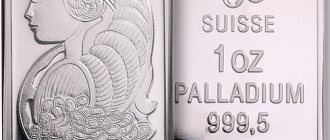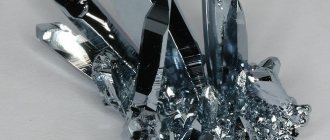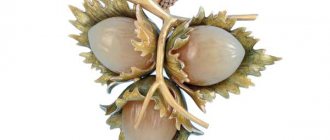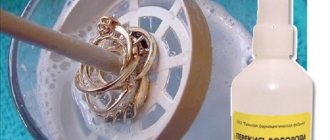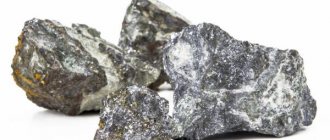The word Affinage comes from the French affiner, which means to purify. Using this method, platinum group metals of the highest standard are obtained. Palladium refining is a type of process for purifying a chemical element from impurities. Since this metal is not found in its pure form, it is extracted from various ores and electronic devices. It is difficult to obtain precious metals industrially, and even more so to repeat the process at home, since you need to use dangerous chemicals. But many amateur chemists set up entire laboratories at home to extract the element in its natural form. How can pure palladium be isolated, and for what purpose is it mined?
Refining methods
There are different methods for extracting precious metals:
- electrolytic;
- wet;
- dry.
Electrolysis is used to reduce palladium. The element is deposited at the cathode, and impurities are separated as sludge. To carry out this experiment, you will need high concentration sulfuric acid. The acid will act as an electrolyte. Lead is suitable for the cathode, and the anode is represented by an electrical part from which a pure element must be isolated. During refining, the copper and brass alloy remains intact. The resulting palladium with impurities is purified using hydrochloric nitric acid.
The advantage of refining carried out by the electrolytic method:
- Low cost of the method.
- The result is a highly purified metal.
- Favorable conditions for workers and the opportunity to extract platinum group precious metals as decay products.
The wet refining method is as follows: palladium and other platinum group elements are dissolved in aqua regia (a mixture of nitric and hydrochloric acids) and then isolated from the resulting solution with reagents - ammonium chloride, ammonia, sugar and others. If a Pd alloy with silver is used, the reagent is nitric acid.
Distilled water is added to aqua regia. Then the mixture is kept for a day. After time, a precipitate forms in the container - silver chloride; it needs to be filtered. Palladium is then reduced with ammonia. It is added to the container and kept for a few more days. The resulting gold solution is filtered. To restore gold, zinc is added to it.
A little hydrochloric acid is poured into the palladium solution. Next, a yellow precipitate with shades of orange appears. After some time, it needs to be filtered, dried and heated to a temperature of 500 degrees. The result is pure precious metal in powder form.
The dry refining method is not used to obtain pure palladium, since this element is not separated from gold and silver impurities during the purification process. Only lead is released, which can oxidize in air and peel off from the silver.
Technology and stages of electrochemical refining
The electrochemical refining method, as stated, is only used for high purity gold. If this precious metal has a purity of less than 900, then its preliminary chemical refining is immediately carried out. After this stage, 950 gold is obtained, which can be subjected to electrochemical refining. After this, it is possible to obtain pure gold of 999.9 purity.
Refining is carried out in several stages. Each of them has its own nuances, but the method is very simple to use. A special container must first be prepared in which the electrodes can be immersed. Typically, the anode is made from gold. Its fineness is 900. The cathode, in turn, is made of a material such as fibrous annealed steel. Its sample is high - 999.9.
Hydrochloric acid serves as an electrolyte together with gold chloride (it dissolves in aqua regia, and then gold chloride is formed). The anode dissolves into a substance to conduct electric current after the current is passed. It is then reduced at the cathode in the form of high-quality gold of the highest purity (999.9). Additional impurities present in the alloy after this stage settle at the bottom of the container.
Due to the simplicity of this method, it is mainly used in production. In this way, gold is produced for bank bullion. It also covers jewelry made from silver or low-grade gold. Electrochemical refining also has one big drawback. This process is quite energy-intensive. During its implementation, frequent replacement of the electrolyte and constant cleaning of the cathode are required.
This method can also be used to clean silver or copper. It allows you to obtain metal with a higher degree of purity. We remind you that such reactions should not be carried out at home. This requires a work permit, specially equipped premises and qualified personnel.
Where to find material
Pd is used in industry for the manufacture of capacitors, relays, contacts and microcircuits. The starting material for palladium refining at home is various radio components containing precious metals. Developers based on Pd alloy improve the service life of chips. The chemical element is also present in KM capacitors as part of a platinum alloy. The precious metal is included in capacitors of radio components produced in Russia and abroad. The content of parent elements in alloys varies, depending on the type of electrical circuit and its operation.
In other devices, the content of precious metals is rare, for example, in transistors. Therefore, such devices are not used in refining to obtain natural metal.
The chemical element Pd has a light tint, making it very similar to silver and platinum. At first glance, an experienced specialist will not always be able to separate it from other precious metals. The density of the platinum group metals is different, but it is difficult to distinguish them by this criterion. Platinum can be separated from Pd by treating them with nitric acid: platinum does not dissolve in it.
To determine whether a particular alloy contains a precious metal, the following experiment is done: a piece of metal is passed over a touchstone, leaving a deep scratch. Then take a reagent prepared from a mixture of nitric and hydrochloric acids with the addition of a 10% solution of potassium with iodine. If a chemical reaction occurs and a red-brown spot appears, then this means that there is palladium in the sample.
Pd is contained in small quantities in radio components. It is most common in ceramic capacitors of the KM -3,4,5,6 type. These models are expensive and in demand, and if there is no desire to conduct chemical experiments to isolate the precious metal, they can be easily sold.
What parts should you look for metal in?
Radio components always contain some kind of precious metals. Platinum, gold and palladium are used by manufacturers to ensure that their products last as long as possible. Therefore, it is from radio components that many amateurs obtain these elements at home.
Due to its properties, Pd is most often present in the design of microcircuits and capacitors. Capacitors of both Russian (Soviet) and imported production palladium is used in the form of an alloy with platinum. The choice of these elements is explained quite simply: the parts must operate stably at high temperatures. Depending on the type of capacitor, the ratio of Pd and Pt in the alloy may vary.
The microcircuits also contain all the “four” precious metals, but palladium may not be alloyed with other elements. But finding palladium in radio components such as transistors is very difficult. If it is present in some models, it is in very small quantities. You can see what different parts from television and radio equipment look like in the photo.
Another use of Pd is in the production of relays and contacts needed in computer assemblies, automobiles, aircraft, and military equipment. The precious metal and its alloys are indispensable in electronics as coatings that are resistant to sulfides. This property gives Pd an advantage over silver.
How can you distinguish palladium from silver in contacts? The metals are similar in appearance to each other and to platinum, so distinguishing them visually is problematic. Pure metals can be compared by density, but this method cannot always be implemented in practice. You can distinguish Pd from Pt using the reaction of a piece of the substance and hot nitric acid: palladium dissolves in it, but platinum does not. The latter can only be dissolved in aqua regia when heated.
How to determine palladium using a touchstone? The process is as follows: a piece of metal is pressed across a touchstone, and then a specially prepared reagent is applied to the scratch. The reagent is a mixture of aqua regia and a 10% solution of potassium iodide. If, as a result of the test, a bright red-brown spot is formed on the scratch, then the sample contains palladium. The reaction is the formation of potassium tetrachloropalladate.
The Pd content in radio components is low, and the reagents for carrying out all chemical reactions and the necessary utensils cost money, so it makes sense to focus only on those parts from which the yield of precious metal will be maximum. What contains the most metal? Palladium is most often tried to be refined from ceramic capacitors. Experts consider capacitors KM-3,4,5,6 to be leaders in element content. Such capacitors themselves cost quite a lot, so if you have no desire to highlight pure metal, then if you want, you can always find a buyer for the parts themselves.
Such parts are usually marked KM and have a digital designation. KM-4.5 capacitors look like rectangles or small squares and can differ in size and color: most often they are painted in different shades of green. The KM-6 capacitor with palladium looks like a small red-colored pillow. There are also unframed capacitor options, which are small gray rectangles. Previously, many such capacitors were part of Soviet computers and other similar equipment, instrumentation, generators, oscilloscopes and other equipment. It is almost impossible to find such equipment now, since almost all of it was dismantled back in the 90s, when “traditional craftsmen” smelted gold at home. The capacitors were simply thrown away, since palladium was not of particular value.
The palladium content of different capacitors varies. Where is it most? The most valuable devices are:
- Oscilloscopes types S-114, 116, 120 and 121, 125, S1-9-9, S9-27, 28;
- Generators types GCh-151, 164 and 165, G3-122, 123, RF6-01;
- Meters E7-14, 15, P2-73, 85 and 86, 102, RF-37;
- Analyzers SCh-60, SCh-74, SCh-82;
- Frequency meter SCH8-68, 74;
- Voltmeter V1-28, V3-63, V7-40 and 46;
- Resistors PP3-43, PPBP, P-74, RPP, PTP-1,2,5;
- Switches BKNB, PG-2, 5, 7, 43, P1T3-1, P1M10, P1M9-1 and others.
The number of parts that contain Pd is quite large. Many people use special tables containing a complete list of radio components with notes on their precious metal content. In order not to make a mistake in selecting the initial raw material for producing Pd, it is better for beginners to thoroughly study radio components containing palladium from photos.
Why is palladium needed?
For what purposes is pure palladium needed? At home, amateur chemists usually extract it chemically and use it in experiments as a catalyst. Businessmen resort to these methods in order to scrap precious metals. Palladium is refined from radioelements precisely for these purposes.
The cost of Pd has recently increased; the price of one gram of metal is more than one thousand rubles. Therefore, it is more profitable to hand over it in its pure form.
Refining palladium is a difficult process to obtain pure metal and therefore requires a good knowledge of chemical reactions. To use this method at home, familiarize yourself with the production technology. The method for isolating Pd will depend on the impurities in the alloy. Metal in radio components is present both in pure form and in the form of an alloy of various elements: platinum, copper, silver, tungsten, bismuth and others.
Chemical properties of the element
Pd as a chemical element is interesting because it is a metal whose electronic configuration is extremely filled: this characteristic of palladium means that the metal has high chemical resistance. It does not react with water, ammonia hydrate, alkalis and acids if the latter are dilute. Under normal temperature conditions, Pd behaves stably in air; oxidation with oxygen begins at a temperature level of 300 °C, and the reaction produces palladium (II) oxide. With further heating above 850 °C, the previously formed oxide again decomposes into metal and oxygen, and palladium itself again becomes resistant to the oxidation process.
Pd can only be affected by concentrated acids: it can be dissolved in sulfuric or nitric acid. Just like gold, the element will dissolve in aqua regia.
The electronic formula of the outer shell of a palladium atom is 4d10; there are 18 electrons in the outer orbit of the element - it is completely filled. It is this feature that explains the “reluctance” of the element to react under normal conditions even with fluorine. At the same time, Pd is considered the most active of all platinoids. In compounds it is most often divalent, but it can also form tri- and quadrivalent compounds.
At room temperature, the metal can react with wet chlorine, forming palladium chloride. Under similar conditions, a reaction occurs with wet bromine. With sulfur, arsenic, silicon, as well as strong oxidizing agents, which include fluorine, the reaction is possible only when heated above 500 °C. Pd actively absorbs hydrogen, which is then found in the metal in the form of atoms. The peculiarity of the reaction is such that at room temperature, 1 volume of metal absorbs more than 900 volumes of hydrogen - it is this property that made it possible to use palladium in the manufacture of automobile neutralizers. Today, 70% of the element's annual production is consumed by the automotive industry.
The valence of an element in compounds can be different, so it is possible to obtain di- and trivalent palladium oxides, mono-, di- and tetravalent palladium sulfides, as well as other salts and compounds classified as complex.
Reserves and deposits
In its pure form, palladium nuggets cannot be found in nature. Particles of this metal are extracted along with other minerals. There can be more than 30 such compounds in total. By their appearance, grains of palladium can easily be confused with platinum. Some deposits contain both of these metals at the same time, which are mined together. Occasionally veins of palladium intersect with gold.
The main source of the appearance of this metal on planet Earth is cosmic fragments of meteorites. It is in them that a large number of crystals of this precious metal are found.
Nugget of gold (Photo: Instagram / in_sochi)

